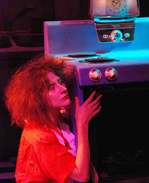SITE GUIDE
SEARCH
REVIEWS
REVIEW ARCHIVES
ADVERTISING AT CURTAINUP
FEATURES
NEWS
Etcetera and
Short Term Listings
LISTINGS
Broadway
Off-Broadway
NYC Restaurants
BOOKS and CDs
OTHER PLACES
Berkshires
London
California
New Jersey
DC
Connecticut
Philadelphia
Elsewhere
QUOTES
TKTS
PLAYWRIGHTS' ALBUMS
LETTERS TO EDITOR
FILM
LINKS
MISCELLANEOUS
Free Updates
Masthead
A CurtainUp Review
Wish I Had a Sylvia Plath
|
It's the purest of lives, the poet's life. Before family and husband and children, I remember working from dawn until dusk. Worshipping words, swimming in sounds, praying for poems— and receiving them. — Esther
|

Elisabeth Gray
(Photo: )
|
A caveat about my calling Anthony's play comic. Given that it deals with suicide, sex and domestic abuse it's not for the weak-stomached, The oven that was famously used by Plath as her weapon of self destruction is what meets the eye even as one enters the theater — and poking out from that oven is a young woman's rear end. She's wearing a bright red dress with matching red shoes, reminiscent of Dorothy from the The Wizard of Oz. No sooner does one take in this ghastly tablea than the lights fade and we hear Doris Day's "Que Sera, Sera" eerily accompanied by the sound of hissing gas fumes.
Actually Anthony's brilliant but disturbed protagonist is named Esther Greenwood (Elisabeth Gray), exhumed from the pages of Sylvia Plath's The Bell Jar. In the course of 70 minutes she's brought to brittle life and we eavesdrop on her grimly planning and executing suicide.
The framing device for the setting — a surrealistic 1950s kitchen (the oven talks!) at 3 a.m. — is a cooking show à la Martha Stewart, with Esther, in the persona of cooking-show hostess. We thus see her "mix, blend, and whip her memories" into a perfect poem before Olson the Talking Oven can whisk her away forever. There's also tete-a-tete with celluloid characters featured in short black-and-white silent films (multi-media effects by John Farmanesh-Bocca) that are projected on an enormous quilt that doubles as a set. The solo format is also enlivened by occasional celluloid appearances of her philandering husband Ned Pews (a stand-in for Sylvia Plath's real-life husband and famous poetTed Hughes), her 2 young children, her mother Azalea, some Oxford partygoers, and one sex kitten Anya dubbed the "Babylonian Whore."
Essentially this is a strikingly and quite original spectacle of a woman confronted by an unfaithful and ambitious husband, and the specters of her failures as a poet and wife. Anthony depicts Esther, a name that means "star" in Hebrew) become, as it were, a modern-day Cleopatra. The talented Elisabeth Gray stages her suicide with grandiosity, employing a domestic ritual centered around the talking oven, which ultimately doubles as her tomb. Though this clever device doesn't always work, it's s not likely that you'll look at an oven in the same way again for a long time.
One of this play's strength is that it authentically creates the aura of the social climate of the Eisehhower era, with its rising birth rate and expectations for womn to stay home, care for their children and support their husband's career. Anthony lets us see a lot of one-upping between husband and wife here with their acute competitiveness played out in both their literary careers and family life. He wisely doesn't tack on a moral or message, but lets the drama speak for itself.
Gray is as versatile as she is talented. She not only portrays Esther but dubs the voices of the talking oven as well as the muted characters in the silent filmed sequences. Gray's Esther has a commedia dell'arte look and feel, and with her hair spiked out she resembles a kind of new-fangled Medusa. You may not like the choices that the character Esther makes in the play, but you will definitely learn more about Sylvia Plath's life and art with Gray's spot-on acting.
Ultimately, this play is an exploration of a woman who had a congenital and tempermental inability to face anything but perfection. Whether it was her poetry or her family life, she wanted nothing that was mediocre, boring, or mundane. Plath's story and this staging is surprisingly funny and entertaining — and for Plath enthusiast or scholars, a must-see.
|
Wish I Had a Sylvia Plath Written by Edward Anthony Directed by Daniel S. Zimbler Cast: Elisabeth Gray (Esther Greenwood). Sets: Shane Meador Multimedia: John Farmanesh-Bocca Costumes: Jane Parker Lighting: Nicole Blastow Stage Manager: Casey Schmal 59E59 Theatres at 59 East 59th Street. 212/279-4200 online at www.59e59.org From 10/05/10; opening 10/10/10/closing 10/31/10. Tuesday @ 7:30pm; Wednesday @ 1pm and 7:30pm; Thursday-Friday @ 8:30pm; Saturday @ 2:30pm and 8:30pm; Sunday @ 3:30pm. Tickets: $25 Running time: 70 minutes without intermission Reviewed by Deirdre Donovan based on October 9th press performance. |
|
REVIEW FEEDBACK Highlight one of the responses below and click "copy" or"CTRL+C"
Paste the highlighted text into the subject line (CTRL+ V): Feel free to add detailed comments in the body of the email. . .also the names and emails of any friends to whom you'd like us to forward a copy of this review. Visit Curtainup's Blog Annex For a feed to reviews and features as they are posted add http://curtainupnewlinks.blogspot.com to your reader Curtainup at Facebook . . . Curtainup at Twitter Subscribe to our FREE email updates: E-mail: esommer@curtainup.comesommer@curtainup.com put SUBSCRIBE CURTAINUP EMAIL UPDATE in the subject line and your full name and email address in the body of the message |
|
Subscribe to our FREE email updates with a note from editor Elyse Sommer about additions to the website -- with main page hot links to the latest features posted at our numerous locations. To subscribe,
E-mail: esommer@curtainup.comesommer@curtainup.com
put SUBSCRIBE CURTAINUP EMAIL UPDATE in the subject line and your full name and email address in the body of the message -- if you can spare a minute, tell us how you came to CurtainUp and from what part of the country. |



